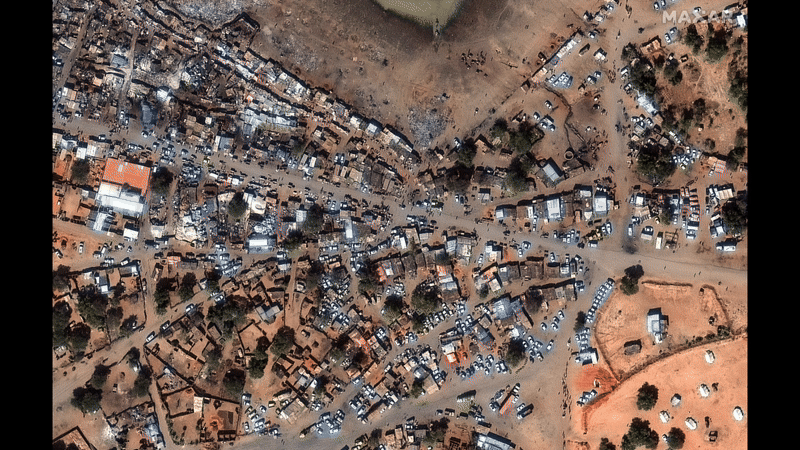Unveiling the Aftermath: Satellite Images Capture Sudan Refugee Camp Destruction
Recent satellite imagery has brought to light the profoundly devastating impact of a raid on a refugee camp in Sudan. As these images reveal burned structures and widespread destruction, they also highlight the escalating humanitarian crisis that unfolds in the wake of such violence. This visual evidence raises urgent questions about safety and aid in conflict zones, compelling the international community to reassess its response strategies.
The Humanitarian Crisis Unfolding in Sudan
Sudan has long been embroiled in conflict, with the Darfur region being a focal point of violence and displacement. Millions of people have sought refuge in camps, hoping to find safety and basic necessities. However, the recent satellite images of the destroyed refugee camp serve as a stark reminder of how fragile this hope can be. The destruction reveals more than just physical damage; it encapsulates the fear, uncertainty, and trauma experienced by those who have already endured significant suffering.
Understanding the Satellite Imagery
Satellite imagery is a powerful tool that provides an aerial view of areas impacted by conflict. In this case, high-resolution images depict:
- Burned Structures: The most striking feature of the recent images is the charred remains of shelters that once housed families seeking refuge.
- Displacement Patterns: The imagery can help identify patterns of displacement, showing how and where people are fleeing from violence.
- Infrastructure Damage: Essential facilities such as water points and medical centers have been compromised, highlighting the urgent need for humanitarian assistance.
These images are not just data points; they represent lives disrupted and futures uncertain, drawing attention to the critical need for humanitarian aid in the region.
The Role of Humanitarian Organizations
In the face of such devastation, humanitarian organizations play a crucial role in providing aid and support. However, their efforts are often hindered by ongoing violence and instability. Some key organizations involved in Sudan include:
- The United Nations High Commissioner for Refugees (UNHCR): Focused on protecting and assisting refugees, the UNHCR works to ensure that those displaced receive essential services.
- Doctors Without Borders (Médecins Sans Frontières): This organization provides emergency medical care in conflict zones, often risking their safety to deliver vital healthcare.
- The International Rescue Committee (IRC): The IRC offers a wide range of services, including health care, education, and economic support to refugees and displaced persons.
Despite the challenges, these organizations strive to deliver aid where it is most needed, often relying on innovative solutions to overcome obstacles posed by conflict.
Challenges in Delivering Aid
The aftermath of the raid on the Sudan refugee camp exemplifies the myriad challenges faced by humanitarian organizations:
- Security Risks: Aid workers often face threats from armed groups, making it dangerous to deliver assistance in conflict zones.
- Access Restrictions: Blockades and checkpoints can prevent humanitarian aid from reaching those in need, exacerbating the crisis.
- Funding Shortages: Many organizations are struggling with limited resources, which can hinder their ability to respond effectively.
These challenges highlight the need for increased international support and a comprehensive approach to addressing the humanitarian crisis in Sudan.
The International Community’s Response
The images of destruction and the plight of displaced individuals have prompted calls for action from the international community. Several avenues for response include:
- Increased Humanitarian Aid: Governments and organizations are urged to augment funding and resources for humanitarian relief efforts.
- Diplomatic Efforts: Engaging in dialogue with conflicting parties can pave the way for ceasefires and improved conditions for aid delivery.
- Awareness Campaigns: Raising public awareness about the situation in Sudan can spur advocacy and support for those affected by the crisis.
As the global community becomes more informed about the realities on the ground, there is a greater chance for concerted efforts to address the urgent needs of those impacted by the conflict.
Looking Ahead: The Road to Recovery
While the current situation in Sudan is dire, there is hope for recovery and rebuilding. Initiatives that focus on:
- Community Resilience: Empowering local communities to rebuild their lives and infrastructure can foster long-term recovery.
- Education and Psychosocial Support: Providing education and mental health services can help individuals cope with trauma and rebuild their futures.
- Advocating for Peace: Sustained diplomatic efforts and peacebuilding initiatives are essential to prevent future conflicts and ensure stability.
With the right support and commitment from both local and international stakeholders, it is possible to transform the aftermath of destruction into a foundation for healing and progress.
Conclusion
The satellite images capturing the destruction of the Sudan refugee camp serve as a poignant reminder of the humanitarian crises that persist in conflict zones. They compel us to recognize the resilience of those affected and the urgent need for global action. As we work towards understanding and addressing the complexities of such crises, it is imperative that we prioritize the safety and well-being of vulnerable populations. Only through a collaborative and comprehensive approach can we hope to alleviate suffering and pave the way for a brighter future for those impacted by violence in Sudan.
See more Update My News



